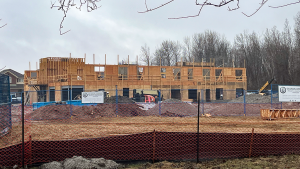As the construction sector plans for the post-pandemic recovery, governments and stakeholders alike have important roles to play in recruiting new workers displaced from other sectors and enhancing current training and apprenticeship programs as mechanisms to bolster the construction workforce.
That’s the view of Kevin Bryenton, a 30-year, second-generation member of Iron Workers Local 721 in Toronto and national general vice-president of the international trade union.
Bryenton participated in a delegation of Canada’s Building Trades Unions (CBTU) executives advocating on various issues with federal Minister of Employment, Workforce Development and Disability Inclusion Carla Qualtrough earlier this month.
Bryenton responded to questions from the Daily Commercial News about the role labour can play as groups such as the new Ontario Jobs and Recovery Committee plan to boost the economy.
Governments must accelerate their co-operation with employers and workers groups to support current efforts to provide a trained workforce that can fully participate in the recovery, Bryenton said.
“Government can play a part in the training side for registered apprenticeships via the enhancement of current collaborations such as the Union Training Innovation Fund and various completion grants that are currently offered to apprentices moving through the training for their trades,” he remarked. “Increasing the monies that are granted to apprentices who complete, offering enhancements to apprenticeship loans and easing the restrictions for collection of necessary funds such as employment insurance benefits and other CERB (Canada Emergency Response Benefit) related funds for those seeking a start in any of our trades are all things the CBTU is engaging various ministries for support.”
With millions thrown out of work in other sectors, said Bryenton, it’s an opportunity for trade unions to reach out to service-sector workers who are not part of the essential services, young workers and students leaving college and universities. He said service industries will take a long time to ramp up to full employment and laid-off workers will be “fishing for jobs in a much shallower pool.”
In contrast, he argued, when a construction worksite reopens, there is full employment on the job right away, which is why the construction sector will play an important role in the recovery.
“A project that employed 50 people prior to shutdown will employ 50 people the day the economy reopens — or potentially more due to schedule slip,” Bryenton remarked. “Construction can scale employment up immediately and as such is a vital focus for a successful re-emergence from this pandemic.
“Entering into a skilled construction trade where construction is put forward as a vital portion of recovery efforts will offer the meaningful, well-paid employment that has all but evaporated due to the pandemic.”
His trade will be much in demand if governments opt for stimulus spending on transit projects, Bryenton said.
They build “transportation (bridges, subways, LRT), any building that involves structural steel or reinforcing steel, any manufacturing that involves machinery and conveyors,” he said.
Follow the author on Twitter @DonWall_DCN.











My two sons are ironworkers 720, both work away from the union because of the corruption in their hall , fix your union before asking for new members to discourage